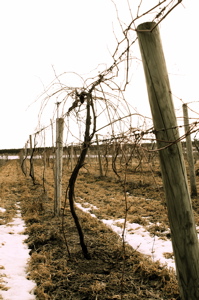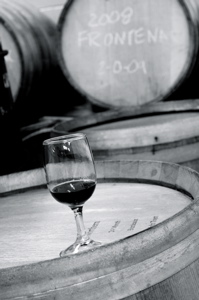
Minnesota’s frigid climate has its perks: ice-fishing, skiing, winter carnivals, lower real-estate prices, and the use of a one’s porch or garage as a giant walk-in freezer, to name a few. But it’s an indisputable obstacle for locals who want to make great wine.
Nan Bailly of Alexis Bailly Vineyard in the Hiawatha Valley says: “People will tell you that you can grow grapes in Minnesota. But I have been growing grapes longer than anybody and I will tell you that you can’t.” Bailly is one of the many vintners who battle year after year to sustain grape vines in the state’s harsh climate.
The Minnesota cold is perpetually challenging for wine makers, but their persistence and perseverance has built a wine industry that has obtained recognition from in international competitions. Peter Hemstad, the grape breeder at the University of Minnesota Horticulture Research Center, has been influential in the Minnesota wine industry, helping to develop many of the grapes used by Minnesota vintners. Hemstad and the University recently released the Marquette grape, a variety designed to endure harsh winters and yield Pinot Noir type characteristics. The Frontenac, Frontenac gris, and La Crescent are the other cold-hardy grapes that the University has released over the past six years.

These grapes have been significant in developing the Minnesota wine industry, but they have not come without criticism. These grapes have yet to yield consistent crops that are needed for a commercial wine industry. Bailly says that “grapes from the University of Minnesota are not up to standard.” She has tried growing the Marquette grape, but was unable to establish trunks for her vines due to the harsh cold which caused the fruit to drop. Last year she was only able to collect one pound of fruit from all of the Marquette vines that she planted. Hemstad, on the contrary, has claimed to have great success with the grape at St. Croix Vineyards in Stillwater and plans to release the wine this year.
By contrast, Bailly has successfully grown many French varietals such as Foch and Millot. These varietals were planted by her father, David Bailly, in 1973 when he founded the vineyard. She says: “I grow French grapes because I think they make better wine.” These labor-intensive grapes require burying the vines to allow them to endure the cold winters, unlike the Frontenac, which has been recorded enduring -35°F and requires no burying.
Local wine makers face challenges beyond mere weather. To be a certified winery in the state of Minnesota, the majority of the product used must be Minnesota grown. This has limited vintners from bringing in juice from other regions of the world. Many wine makers have built connections with vintners around the world and prefer to bring in juice from other growers to use in their blends or to supplement their harvest.

In the early 1970s Bailly worked in the Loire Valley of France. There she learned the fundamentals of wine making, which has paid off in subsequent years. In 2006, Bailly received an award from the VinoChallenge for the best wine in North and Latin America for her Voyageur blend, a Frontenac based wine.

Bailly says that “in order to make wine you have to know how to taste wine,” a skill that she credits to her time spent in France.
Experience notwithstanding, Bailly has found it difficult to pursue wine making due to regulations put on Minnesota wine makers. Minnesota law requires that Minnesota wine makers use at least 51% of grapes grown in Minnesota to be a certified Minnesota winery. This has forced vintners to open gift shops and host events in an attempt to economically compensate for inconsistent harvests.
Maureen and John Maloney of Cannon River Winery have found more options for making wine without bringing juice in from other areas of the world. They use varietals developed by Elmer Swenson, a grape breeder from Osceola, WI, who passed away in 2004. Swenson developed popular grapes such as the St. Pepin, Prairie Star, Brianna and the Somerset Seedless, commonly known as the hardiest cold weather grape. The grapes that Swenson developed have expanded the list of options for wine makers, but for a talented wine maker like Nan Bailly, these grapes are a limitation to her abilities.
Bailly says that she likes “wines with complexity and some sort of depth.” Grapes like the Frontenac yield a wine that is full bodied and earthy with rich dark berries in the nose and into the glass. For the aspiring wine drinker it is approachable and easily agreeable. For the seasoned wine drinker like Nan Bailly, this type of grape makes a one dimensional taste unlike the grapes of France, Italy and Napa Valley, which yield layers of flavor that develop as the wine warms and ages, creating an experience that is intricate and involved.

Bailly uses the Frontenac in a blend with French grapes to bring depth to the wine and develop the palette of those who drink her wine. She continues to produce a small amount of one hundred percent Frontenac to allow her customers to experience Frontenac by itself.

Bailly and others have worked with the climate with the resources they have to develop Minnesota wine. The industry will never birth wines of the same caliber as those of Napa and France, but they can make wine that pleases not only the locals, but also to the palettes of the experienced wine drinkers. The Minnesota industry continues to grow — it contributed $36.2 million to the state’s economy in 2007, an insignificant amount compared to the $30 billion the California wine industry generated in 2007. In terms of volume, 79,000 gallons of wine were produced in Minnesota in 2007; in California, the number was 554 million gallons. The largest vintners in Minnesota would be boutique shops in Napa Valley.
The snow will soon melt and vintners will soon return from hibernation. As they sharpen their pruning sheers the same questions will be asked again; Will there be a crop to harvest and can the vines survive another season? The answer is unknown, but for the wine maker in Minnesota, it doesn’t even matter. They are persistent and patient because Minnesota wine is beyond hard work, it is a miracle.
A Selection of Minnesota Vineyards
Cannon River Winery: Cannon River
Carlos Creek Winery: Alexandria
Falconer Vineyards Winery: Red Wing
Goose Lake Farm & Winery: Elk River
Luedke’s Winery: Princeton
Morgan Creek Vineyards: New Ulm
Northern Vineyards Winery: Stillwater
Olde Country Winery: Lake Lillian
Saint Croix Vineyards: Stillwater
Santiago’s Winery: Alexandria
Scenic Valley Winery: Lanesboro
WineHaven Winery: Chisago City

Although I sympathize with the difficulties of growing grapes and making wine in Minnesota/Wisconsin, I do wonder what value there is in an industry this is not obligated to use at least half locally grown grapes to be called a regional wine. Is a wine that is bottled locally but with grapes grown and some of the vinification taking place out of region really a local wine? Or is it a gimmick and/or some sort of mistruth in labeling?
More power to wineries as tourism engines and agricultural experiments. But if we’re really going to call it a Minnesota wine, I believe it should be made in large measure with locally grown grapes.
Cheers Adam!
You hit the proverbial nail right on the head! Fieldstone Vineyards (Morgan, MN) has been 100% MN grown for the last three vintages. We have true MN wine AND our guests like the wine!
Charlie Quast
Fieldstone Vineyards
Right on Adam. If you want to make California wine go to California and make wine there. Minnesota wine should be grown and produced in Minnesota. The grapes that have been developed by the U of MN and Elmer Swenson are winning national awards, why would you want to make the same wine that they make some where else. There are hunderds of grapes now being grown very successfully in MN and the Midwest. If you are having problems growning grapes we can help you. We have 12 acres of grape at Winterhaven and will open our winery in the spring of 2010. There are many people enjoying the wonderful wines being produced by the wineries in MN and the Midwest so don’t let anyone tell you we can’t grow good wine grapes or make good wine from these grapes, in MN , it simply is not true. Ray A. Winter Winterhaven Vineyard and Nursery
The idea that grapes don’t grow in Minnesota is ludicrous at this point. Now that there are more than 800 acres of grapes in Minnesota and more than two dozen wineries, it’s pretty clear that grapes do grow here! Why is the industry expanding so rapidly if it’s such a futile exercise trying to grow grapes in Minnesota? The tired old concept that we can’t grow quality grapes around here so we need to import more than 50% of what we produce from other states should be put to rest forever.
There seem to be many quotes that directly contradict themselves in this article (“you can’t -(grow grapes in Minnesota)” then refers to growing Foch and Millot in Hastings.
Either way it seems a “Farm Winery” certified in MN would want to utilize grapes (and possibly other fruits) from MN. It lends to the concept/growth of Agrotourism and buying local. Not doing so muddies the concept of regional products being from the region if the source material can come from anywhere.
Carlos Creek Winery would love to have you come on up to Alexandria and try a few great Minnesota wines for yourself! We are new owners of this 10 year old winery and have introduced 5 new wines in the past 6 months made from Minnesota fruit. These wines have been enthusiatically received by our customers. Our new Minnesota Nice series: Hot Dish Red, Wobegon White & Rose, Eh? now account for 50% of our wine sales, even though they are made from those “one-dimensional” grapes some find so difficult to grow. Indeed, our customers ask for Minnesota Grown.
And with respect to the comment about vinters opening gift shops for survival, what about Napa, Sonoma, Willamette, Yakima, Walla Walla, ect. vinters? These wineries have long staged summer concert series and operated tasting rooms that rival Pottery Barns. This just makes smart business sense. Economic diversity is essential to sustain any business, and agrotourism is no different.
Is this article out of date? I have never had a problem growing my several acres of wine grapes in MN. But, unlike Bailey, I stay away from Foch, etc., that need special care and covering in the winter. With the labor involved with Foch and similar grapes, and the lack of quality they offer, growing them is nuts. Plus, Bailey doesn’t make MN wine – They import juice to make imported wines in MN. There are dozens of varieties that grow very well in MN: Frontenac, Front Gris, Marquette, Prairie Star, Sabrevois, etc., grow like weeds in MN. The hard part is keeping them pruned so your acreage isn’t overrun. We have more direct sunlight here in the summer than they do in the California wine country! Plus, there are some great Mn wines – Made from 100% MN grapes. The new Port at Woodland Hill Winery from Frontenac is the best Port I have ever had, anywhere in the world. Their Red wine from Marquette can easily compete with California Cabernets. Anyone who says you can’t grow grapes in MN (grapes grow wild here) or can’t make excellent wine from MN grapes needs to re-learn both skills. Yes, our grapes are a little more acidic, but if you process accordingly it really isn’t that big of a problem.